Page 9 of 87
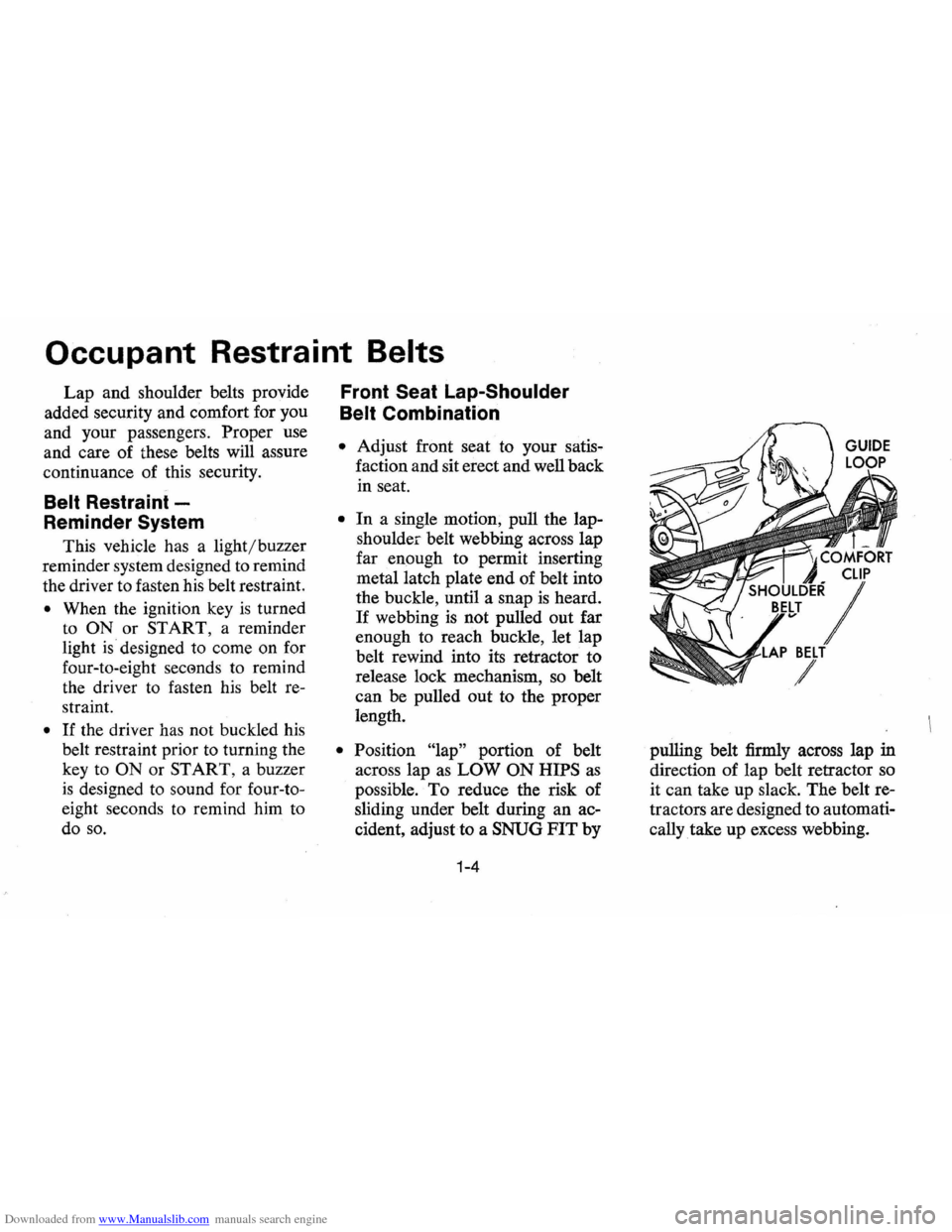
Downloaded from www.Manualslib.com manuals search engine Occupant Restraint Belts
Lap and shoulder belts provide
added security and comfort for you
and your passengers.
Proper use
and care of these belts will assure
continuance of this security.
Belt Restraint -
Reminder
System
This vehicle has a light /buzzer
reminder system designed
to remind
the driver to fasten his belt restraint.
• When the ignition key is turned
to
ON or START, a reminder
light
is designed to come on for
four-to-eight
secends to remind
the driver to fasten
his belt re
straint.
• If the driver has not buckled his
belt restraint prior
to turning the
key to
ON or START, a buzzer
is designed to sound for four-to
eight seconds to remind him to
do
so.
Front Seat Lap-Shoulder
Belt
Combination
• Adjust front seat to your satis
faction and sit erect and well back
in seat.
• In a single motion, pull the lap
shoulder belt webbing across lap
far enough to permit inserting
metal latch plate end of belt into
the buckle, until a snap
is heard.
If webbing is not pulled out far
enough to reach buckle, let lap
belt rewind into its retractor to
release lock mechanism,
so belt
can be pulled out to the proper
length.
• Position "lap" portion of belt
across lap
as LOW ON HIPS as
possible. To reduce the risk of
sliding under belt during an ac
cident, adjustto a
SNUG FIT by
1-4
COMFORT
"7 BELT
/
pulling belt firmly across lap in
direction of lap belt retractor so
it can take up slack. The belt re
tractors are designed to automati
cally .take
up excess webbing.
Page 10 of 87
Downloaded from www.Manualslib.com manuals search engine ·. __ .-
• The front seat shoulder belts in
this vehicle are equipped with a
"vehicle sensitive retractor"
which is designed to lock only
during a sudden stop or impact.
At other times it
is designed to
move freely with the occupant .
• A comfort clip is provided for
those who find the shoulder belt
tension a source of discomfort.
If
the shoulder belt tension becomes
uncomfortable , pull down on the
shoulder belt to provide the
least
amount of slack necessary to re
lieve tension (not more than one
inch), then push the comfort clip
snugly against the guide loop.
• To unfasten belts, depress push
button in center of buckle.
1-5
• When no longer in use, front seat
lap-shoulder belts can be stowed
Page 11 of 87
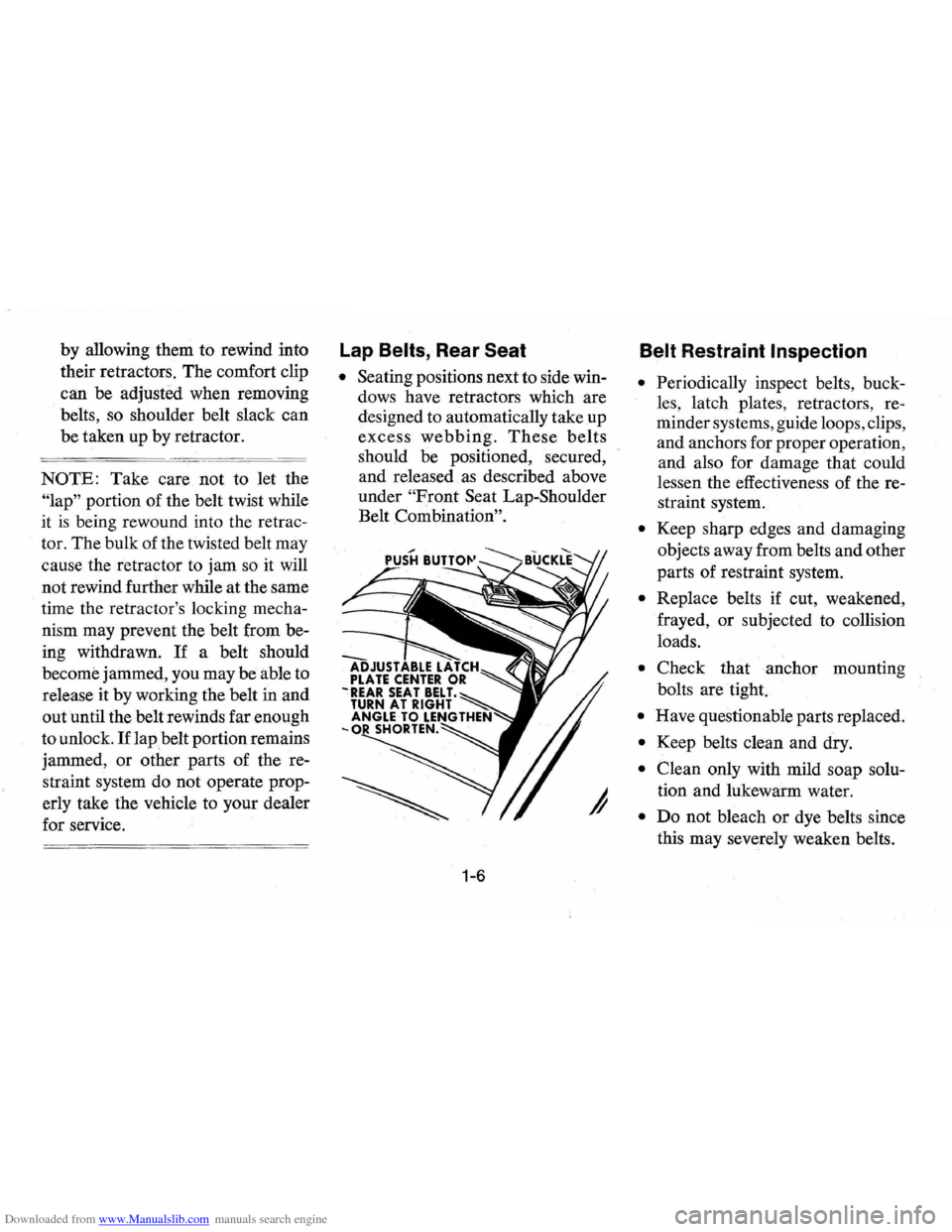
Downloaded from www.Manualslib.com manuals search engine by allowing them to rewind into
their retractors. The comfort clip
can be adjusted when removing
belts,
so shoulder belt slack can
be taken up by retractor.
NOTE: Take care not to let the
"lap" portion of the belt twist while
it
is being rewound into the retrac
tor. The bulk of the twisted belt may
cause the retractor to jam
so it will
not rewind further while at the same
time the retractor's locking mecha
nism may prevent the belt from be
ing withdrawn.
If a belt should
become jammed, you may be able to
release it by working the belt in and
out until the belt rewinds far enough
to unlock.
If lap belt portion remains
jammed, or
other parts of the re
straint system do not operate prop
erly take the vehicle to your dealer
for service.
Lap Belts, Rear Seat
• Seating positions next to side win
dows have retractors which are
designed to automatically take up
excess
webbing. These belts
should be positioned, secured,
and released
as described above
under
"Front Seat Lap-Shoulder
Belt
Combination".
1-6
Belt Restraint Inspection
• Periodically inspect belts, buck
les, latch plates, retractors, re
minder systems, guide loops, clips,
and anchors for proper operation,
and also for damage that could
lessen the effectiveness of the re
straint system.
• Keep sharp edges and damaging
objects away from belts and other
parts of restraint system.
• Replace belts if cut, weakened,
frayed,
or subjected to collision
loads.
• Check that anchor mounting
bolts are tight.
• Have questionable parts replaced.
• Keep belts clean and dry.
• Clean only with mild soap solu
tion and lukewarm water.
• Do not bleach or dye belts since
this may severely weaken belts.
Page 12 of 87
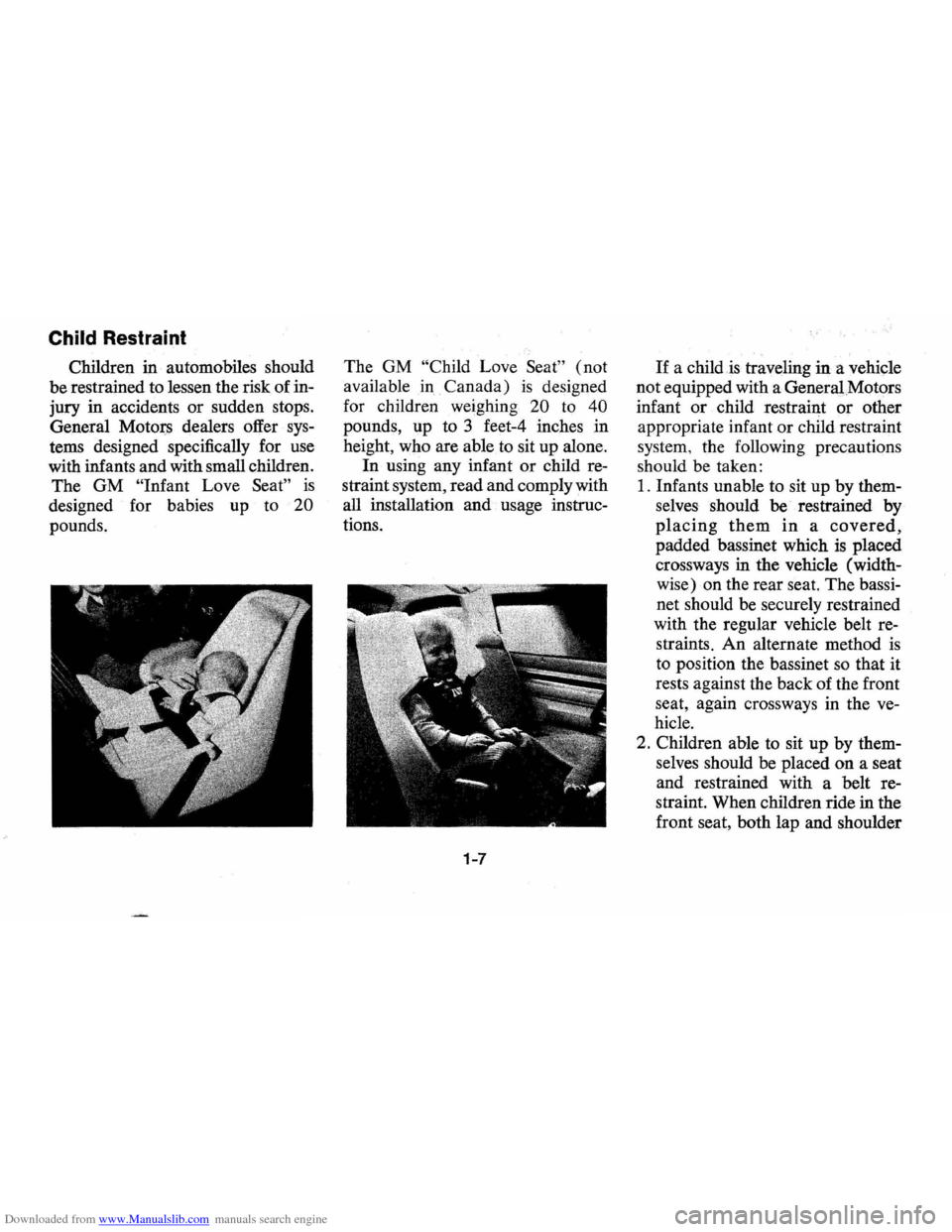
Downloaded from www.Manualslib.com manuals search engine Child Restraint
Children in automobiles should
be restrained to lessen the risk of in
jury in accidents
or sudden stops.
General
MotOl:S dealers offer sys
tems designed specifically for use
with infants and with small children.
The GM
"Infant Love Seat" is
designed for babies up to 20
pounds. The
GM
"Child Love Seat" (not
available in Canada)
is designed
for children weighing
20 to 40
pounds, up to 3 feet-4 inches in
height, who are
ableto sit up alone.
In using any infant
or child re
straint system, read and comply with
all installation and usage instruc
tions.
1-7
If a child,is traveling in a vehi<;:le
not equipped with a General Motors
infant
or child restraint or other
appropriate infant or child restraint
system , the following precautions
should be taken:
1 . Infants unable to sit up by them
selves should
be· restrained by
placing them in a covered,
padded bassinet which is placed
crossways in the vehicle (width
wise
)on the rear seat. The bassi
net should be securely restrained
with the regular vehicle belt re
straints. An alternate method
is
to position the bassinet so that it
rests against the back of the front
seat, again crossways in the ve
hicle.
2. Children able to sit up by them
selves should be placed on a seat
and restrained with a belt re
straint. When children ride in the
front seat, both lap and shoulder
Page 13 of 87
Downloaded from www.Manualslib.com manuals search engine belt should be worn. If the shoul
der belt causes neck
or face irri
tation due to the child's size, this
may be reduced in some cases by
positioning
the child further in
board.
If serious discomfort con
tinues, the child should
be lap belted
in the rear seat. Never
allow a child to stand
or kneel on
any seat.
3. General Motors recommends that
children be restrained properly
when riding. However, if unusual
conditions prohibit use of re-
1-8
straints and require that a child
must stand, he should stand on
the floor directly behind the
front
seat. This will help minimize the
possibility of injury from frontal
force impacts in the event of such
and accident.
Page 14 of 87
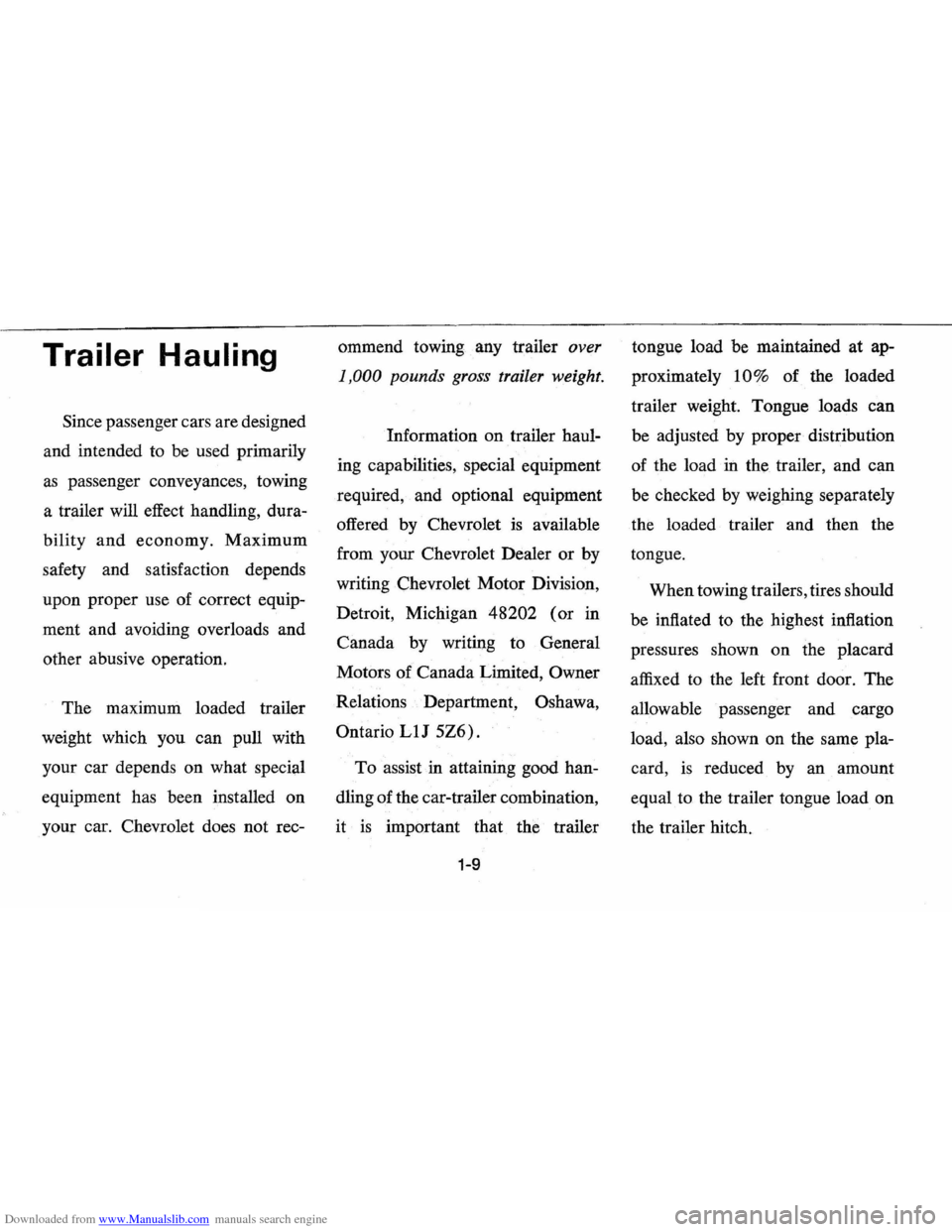
Downloaded from www.Manualslib.com manuals search engine Trailer Hauling
Since passenger cars are designed
and intended to be used primarily
as passenger conveyances, towing
a trailer will effect handling, dura
bility
and economy. Maximum
safety and satisfaction depends
upon proper use of correct equip
ment and avoiding overloads and
other abusive operation.
The maximum loaded trailer
weight which you can pull with
your car depends on what special
equipment has been installed on
your car. Chevrolet does not rec- ommend
towing any trailer
over
1,000 pounds gross trailer weight.
Information on trailer haul
ing capabilities, special equipment
required, and optional equipment
offered by Chevrolet
is available
from your Chevrolet Dealer or by
writing Chevrolet Motor Division,
Detroit, Michigan 48202
(or in
Canada by writing to General
Motors of Canada Limited,
Owner
Relations Department, Oshawa,
Ontario LlJ 5Z6).
To assist in attaining good han
dling of the car-trailer combination,
it
is important that the trailer
1-9
tongue load be maintained at ap
proximately 10%
of the loaded
trailer weight. Tongue loads can
be adjusted by proper distribution
of the load in the trailer, and can
be checked
by weighing separately
the loaded trailer and then the
tongue.
When towing trailers, tires should
be inflated to the highest inflation
pressures shown on the placard
affixed
to the left front door. The
allowable passenger and cargo
load, also shown on the same pla
card,
is reduced by an amount
eq ual to the trailer tongue load on
the trailer hitch.
Page 15 of 87
Downloaded from www.Manualslib.com manuals search engine Maintenance
More frequent vehicle mainte
nance
is required when using your
car to pull a trailer. Change the:
• Automatic transmission fluid
and filter each
15,000 miles,
(see Trailering brochure for addi
tional information).
• Rear axle fluid each 15,000
miles,
• Engine oil each 90 days or 3,000
miles, whichever occurs first,
• Positive crankcase ventilation
valve each
12 months or 15,000
miles, whichever occurs first.
• See index for important informa
tion on belts, cooling system care
and automatic brake adjustment.
Break-in Schedule
In addition to the new car preak-in
instructions in this manual, it is
recommended that your new car
be operated for
500 miles before
trailer towing.
If it is necessary to
tow during this period, avoid speeds
over
50 MPH and full throttle
starts. The same precautions should
be observed whenever a new en
gine, transmission or axle
is in
stalled in your car.
1-10
Page 16 of 87
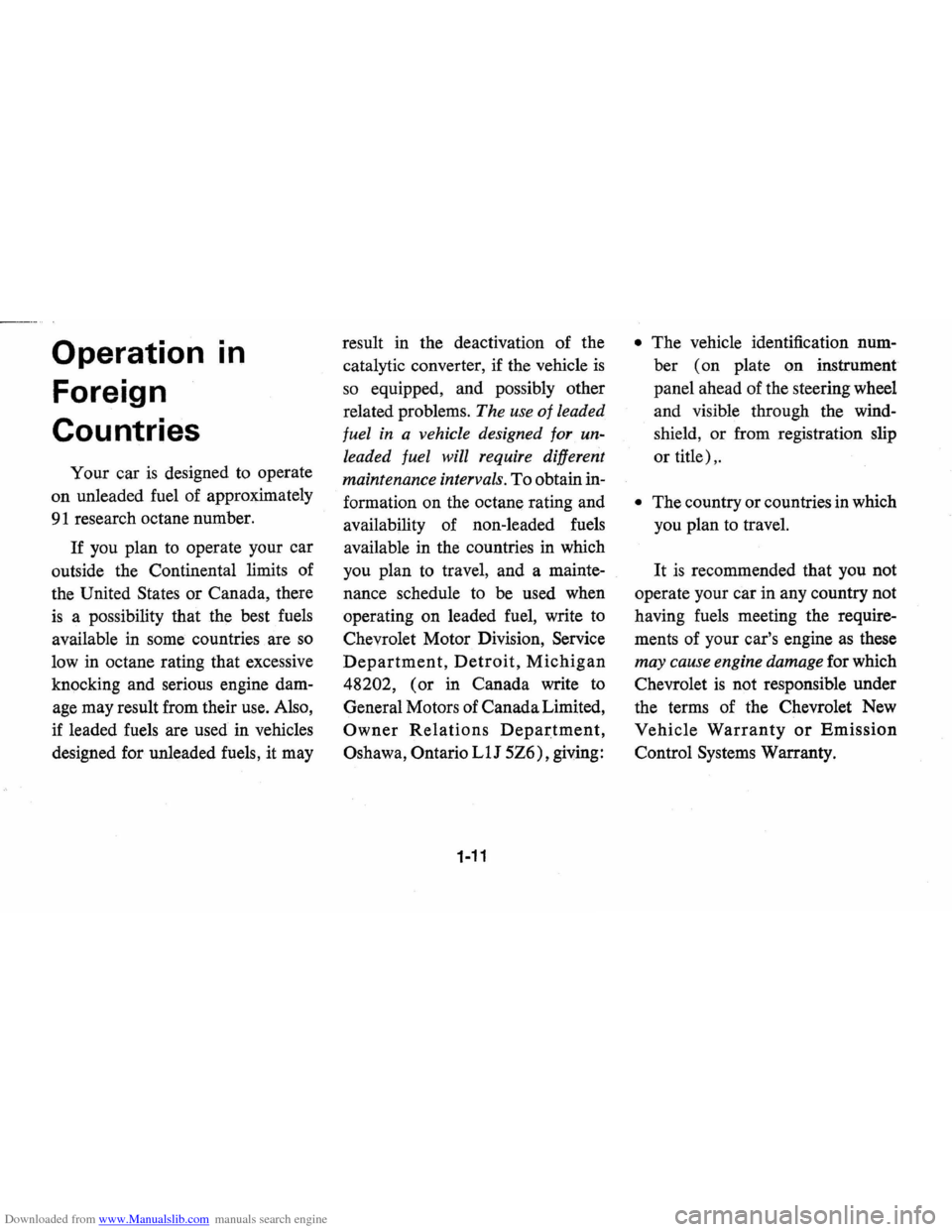
Downloaded from www.Manualslib.com manuals search engine Operation Foreign Countries • In
Your car is designed to operate
on unleaded fuel of approximately
91 research octane number.
If you plan to operate your car
outside the Continental limits of
the United
States or Canada, there
is a possibility that the best fuels
available in some countries are so
low in octane rating that excessive
knocking and serious engine
dam
age may result from their use. Also ,
if leaded fuels are used in vehicles
designed for unleaded fuels, it may result
in the deactivation of the
catalytic converter, if the vehicle
is
so equipped, and possibly other
related problems.
The use of leaded
fuel in a vehicle designed
for un
leaded fuel will require different
maintenance intervals.
To obtain in
formation on the octane rating and
availability of non-leaded fuels
available in the countries in which
you plan to travel, and a mainte
nance schedule to be used when
operating on leaded fuel, write to
Chevrolet Motor Division,
Service
Department, Detroit, Michigan
48202, (or in Canada write to
General Motors of Canada Limited,
Owner Relations Department,
Oshawa, Ontario LlJ 5Z6), giving:
1-11
• The vehicle identification num
ber (on plate on instrument
panel ahead of the steering wheel
and visible through the wind
shield,
or from registration slip
or title),.
• The country or countries in which
you plan to travel.
It is recommended that you not
operate your car in any country not
having fuels meeting the require
ments of your car's engine
as these
may cause engine damage for which
Chevrolet
is not responsible under
the terms of the Chevrolet New
Vehicle Warranty or Emission
Control Systems Warranty.